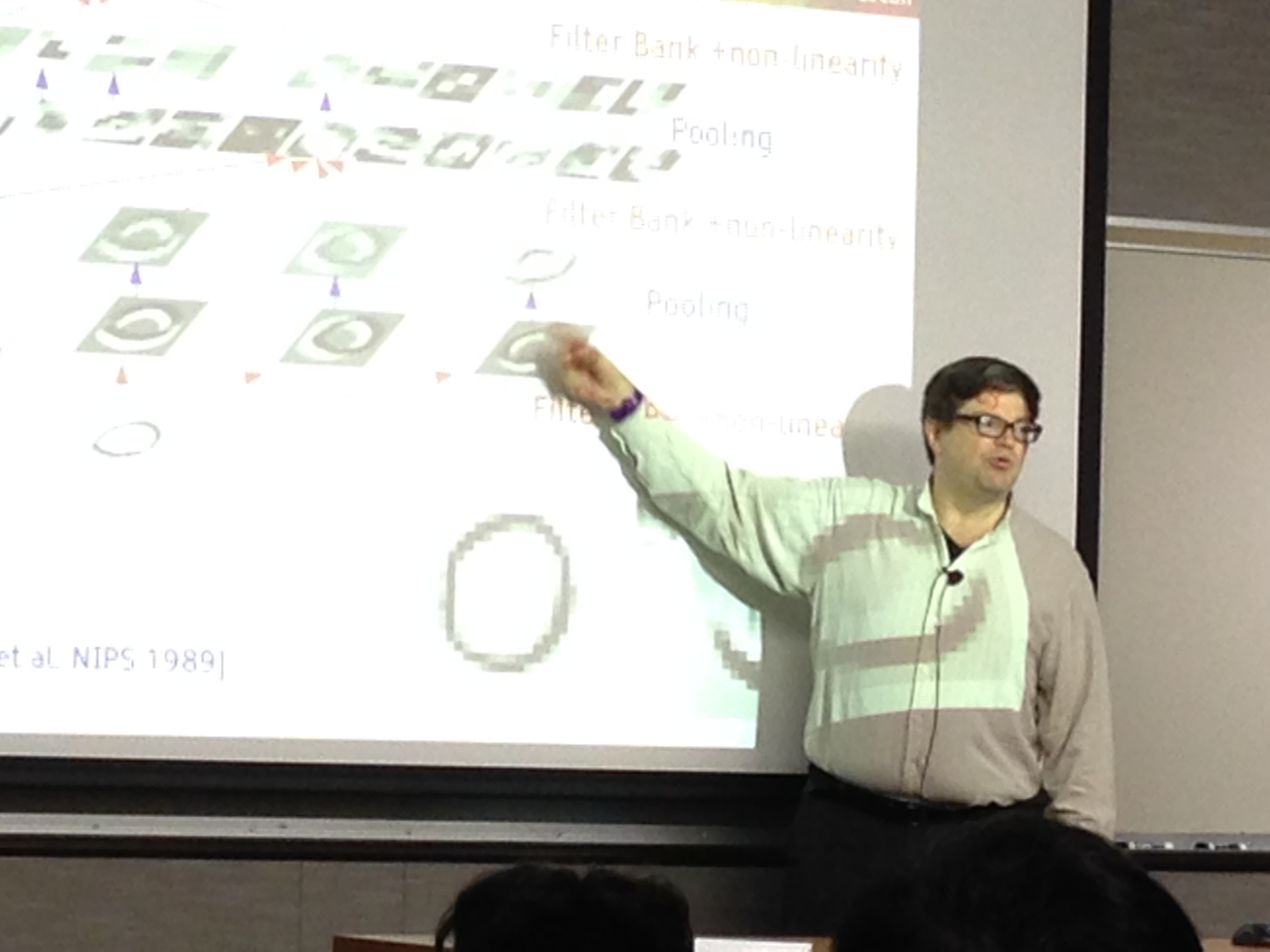|
Existential Risk From Artificial General Intelligence
Existential risk from artificial general intelligence is the hypothesis that substantial progress in artificial general intelligence (AGI) could result in human extinction or some other unrecoverable global catastrophe. It is argued that the human species currently dominates other species because the human brain has some distinctive capabilities that other animals lack. If AI surpasses humanity in general intelligence and becomes "superintelligent", then it could become difficult or impossible for humans to control. Just as the fate of the mountain gorilla depends on human goodwill, so might the fate of humanity depend on the actions of a future machine superintelligence. The chance of this type of scenario is widely debated, and hinges in part on differing scenarios for future progress in computer science. Once the exclusive domain of science fiction, concerns about superintelligence started to become mainstream in the 2010s, and were popularized by public figures such as Steph ... [...More Info...] [...Related Items...] OR: [Wikipedia] [Google] [Baidu] |
Artificial General Intelligence
Artificial general intelligence (AGI) is the ability of an intelligent agent to understand or learn any intellectual task that a human being can. It is a primary goal of some artificial intelligence research and a common topic in science fiction and futures studies. AGI is also called strong AI,: Kurzweil describes strong AI as "machine intelligence with the full range of human intelligence." full AI, or general intelligent action, although some academic sources reserve the term "strong AI" for computer programs that experience sentience or consciousness. Strong AI contrasts with '' weak AI'' (or ''narrow AI''), which is not intended to have general cognitive abilities; rather, weak AI is any program that is designed to solve exactly one problem. (Academic sources reserve "weak AI" for programs that do not experience consciousness or do not have a mind in the same sense people do.) A 2020 survey identified 72 active AGI R&D projects spread across 37 countries. Characteris ... [...More Info...] [...Related Items...] OR: [Wikipedia] [Google] [Baidu] |
Yann LeCun
Yann André LeCun ( , ; originally spelled Le Cun; born 8 July 1960) is a French computer scientist working primarily in the fields of machine learning, computer vision, mobile robotics and computational neuroscience. He is the Silver Professor of the Courant Institute of Mathematical Sciences at New York University and Vice-President, Chief AI Scientist at Meta. He is well known for his work on optical character recognition and computer vision using convolutional neural networks (CNN), and is a founding father of convolutional nets. He is also one of the main creators of the DjVu image compression technology (together with Léon Bottou and Patrick Haffner). He co-developed the Lush programming language with Léon Bottou. LeCun received the 2018 Turing Award (often referred to as " Nobel Prize of Computing"), together with Yoshua Bengio and Geoffrey Hinton, for their work on deep learning. The three are sometimes referred to as the "Godfathers of AI" and "Godfathers of Deep Lea ... [...More Info...] [...Related Items...] OR: [Wikipedia] [Google] [Baidu] |
Vanity Fair (magazine)
''Vanity Fair'' is a monthly magazine of popular culture, fashion, and current affairs published by Condé Nast in the United States. The first version of ''Vanity Fair'' was published from 1913 to 1936. The imprint was revived in 1983 and currently includes five international editions of the magazine. As of 2018, the Editor-in-Chief is Radhika Jones. Vanity Fair is most recognized for its celebrity pictures and the occasional controversy that surrounds its more risqué images. Furthermore, the publication is known for its energetic writing, in-depth reporting, and social commentary. History ''Dress and Vanity Fair'' Condé Montrose Nast began his empire by purchasing the men's fashion magazine ''Dress'' in 1913. He renamed the magazine ''Dress and Vanity Fair'' and published four issues in 1913. It continued to thrive into the 1920s. However, it became a casualty of the Great Depression and declining advertising revenues, although its circulation, at 90,000 copies, was ... [...More Info...] [...Related Items...] OR: [Wikipedia] [Google] [Baidu] |
Nanotechnology
Nanotechnology, also shortened to nanotech, is the use of matter on an atomic, molecular, and supramolecular scale for industrial purposes. The earliest, widespread description of nanotechnology referred to the particular technological goal of precisely manipulating atoms and molecules for fabrication of macroscale products, also now referred to as molecular nanotechnology. A more generalized description of nanotechnology was subsequently established by the National Nanotechnology Initiative, which defined nanotechnology as the manipulation of matter with at least one dimension sized from 1 to 100 nanometers (nm). This definition reflects the fact that quantum mechanical effects are important at this quantum-realm scale, and so the definition shifted from a particular technological goal to a research category inclusive of all types of research and technologies that deal with the special properties of matter which occur below the given size threshold. It is therefore commo ... [...More Info...] [...Related Items...] OR: [Wikipedia] [Google] [Baidu] |
Bill Joy
William Nelson Joy (born November 8, 1954) is an American computer engineer and venture capitalist. He co-founded Sun Microsystems in 1982 along with Scott McNealy, Vinod Khosla, and Andy Bechtolsheim, and served as Chief Scientist and CTO at the company until 2003. He played an integral role in the early development of BSD UNIX while being a graduate student at Berkeley, and he is the original author of the vi text editor. He also wrote the 2000 essay " Why The Future Doesn't Need Us", in which he expressed deep concerns over the development of modern technologies. Joy was elected a member of the National Academy of Engineering (1999) for contributions to operating systems and networking software. Early career Joy was born in the Detroit suburb of Farmington Hills, Michigan, to William Joy, a school vice-principal and counselor, and Ruth Joy. He earned a Bachelor of Science in electrical engineering from the University of Michigan and a Master of Science in electric ... [...More Info...] [...Related Items...] OR: [Wikipedia] [Google] [Baidu] |
Sun Microsystems
Sun Microsystems, Inc. (Sun for short) was an American technology company that sold computers, computer components, software, and information technology services and created the Java programming language, the Solaris operating system, ZFS, the Network File System (NFS), and SPARC microprocessors. Sun contributed significantly to the evolution of several key computing technologies, among them Unix, RISC processors, thin client computing, and virtualized computing. Notable Sun acquisitions include Cray Business Systems Division, Storagetek, and ''Innotek GmbH'', creators of VirtualBox. Sun was founded on February 24, 1982. At its height, the Sun headquarters were in Santa Clara, California (part of Silicon Valley), on the former west campus of the Agnews Developmental Center. Sun products included computer servers and workstations built on its own RISC-based SPARC processor architecture, as well as on x86-based AMD Opteron and Intel Xeon processors. Sun also dev ... [...More Info...] [...Related Items...] OR: [Wikipedia] [Google] [Baidu] |
Marvin Minsky
Marvin Lee Minsky (August 9, 1927 – January 24, 2016) was an American cognitive and computer scientist concerned largely with research of artificial intelligence (AI), co-founder of the Massachusetts Institute of Technology's AI laboratory, and author of several texts concerning AI and philosophy. Minsky received many accolades and honors, including the 1969 Turing Award. Biography Marvin Lee Minsky was born in New York City, to an eye surgeon father, Henry, and to a mother, Fannie (Reiser), who was a Zionist activist. His family was Jewish. He attended the Ethical Culture Fieldston School and the Bronx High School of Science. He later attended Phillips Academy in Andover, Massachusetts. He then served in the US Navy from 1944 to 1945. He received a B.A. in mathematics from Harvard University in 1950 and a Ph.D. in mathematics from Princeton University in 1954. His doctoral dissertation was titled "Theory of neural-analog reinforcement systems and its application to the ... [...More Info...] [...Related Items...] OR: [Wikipedia] [Google] [Baidu] |
Erewhon
''Erewhon: or, Over the Range'' () is a novel by English writer Samuel Butler, first published anonymously in 1872, set in a fictional country discovered and explored by the protagonist. The book is a satire on Victorian society. The first few chapters of the novel dealing with the discovery of Erewhon are in fact based on Butler's own experiences in New Zealand, where, as a young man, he worked as a sheep farmer on Mesopotamia Station for about four years (1860–64), and explored parts of the interior of the South Island and wrote about in his ''A First Year in Canterbury Settlement'' (1863). The novel is one of the first to explore ideas of artificial intelligence, as influenced by Darwin's recently published '' On the Origin of Species'' (1859) and the machines developed out of the Industrial Revolution (late 18th to early 19th centuries). Specifically, it concerns itself, in the three-chapter "Book of the Machines", with the potentially dangerous ideas of machine ... [...More Info...] [...Related Items...] OR: [Wikipedia] [Google] [Baidu] |
Alan Turing
Alan Mathison Turing (; 23 June 1912 – 7 June 1954) was an English mathematician, computer scientist, logician, cryptanalyst, philosopher, and theoretical biologist. Turing was highly influential in the development of theoretical computer science, providing a formalisation of the concepts of algorithm and computation with the Turing machine, which can be considered a model of a general-purpose computer. He is widely considered to be the father of theoretical computer science and artificial intelligence. Born in Maida Vale, London, Turing was raised in southern England. He graduated at King's College, Cambridge, with a degree in mathematics. Whilst he was a fellow at Cambridge, he published a proof demonstrating that some purely mathematical yes–no questions can never be answered by computation and defined a Turing machine, and went on to prove that the halting problem for Turing machines is undecidable. In 1938, he obtained his PhD from the Department of ... [...More Info...] [...Related Items...] OR: [Wikipedia] [Google] [Baidu] |
Darwin Among The Machines
"Darwin among the Machines" is an article published in ''The Press'' newspaper on 13 June 1863 in Christchurch, New Zealand, which references the work of Charles Darwin in the title. Written by Samuel Butler but signed '' Cellarius'' (q.v.), the article raised the possibility that machines were a kind of "mechanical life" undergoing constant evolution, and that eventually machines might supplant humans as the dominant species: The article ends by urging that, "War to the death should be instantly proclaimed against them. Every machine of every sort should be destroyed by the well-wisher of his species. Let there be no exceptions made, no quarter shown; let us at once go back to the primeval condition of the race." ''Book of the Machines'' Butler developed this and subsequent articles into ''The Book of the Machines'', three chapters of ''Erewhon'', published anonymously in 1872. The Erewhonian society Butler envisioned had long ago undergone a revolution that destroyed most mec ... [...More Info...] [...Related Items...] OR: [Wikipedia] [Google] [Baidu] |
Samuel Butler (novelist)
Samuel Butler (4 December 1835 – 18 June 1902) was an English novelist and critic, best known for the satirical utopian novel ''Erewhon'' (1872) and the semi-autobiographical novel ''Ernest Pontifex or The Way of All Flesh'', published posthumously in 1903 in an altered version titled ''The Way of All Flesh'', and published in 1964 as he wrote it. Both novels have remained in print since their initial publication. In other studies he examined Christian orthodoxy, evolutionary thought, and Italian art, and made prose translations of the ''Iliad'' and ''Odyssey'' that are still consulted. Early life Butler was born on 4 December 1835 at the rectory in the village of Langar, Nottinghamshire. His father was Rev. Thomas Butler, son of Dr. Samuel Butler, then headmaster of Shrewsbury School and later Bishop of Lichfield. Dr. Butler was the son of a tradesman and descended from a line of yeomen, but his scholarly aptitude being recognised at a young age, he had been sent to Ru ... [...More Info...] [...Related Items...] OR: [Wikipedia] [Google] [Baidu] |







